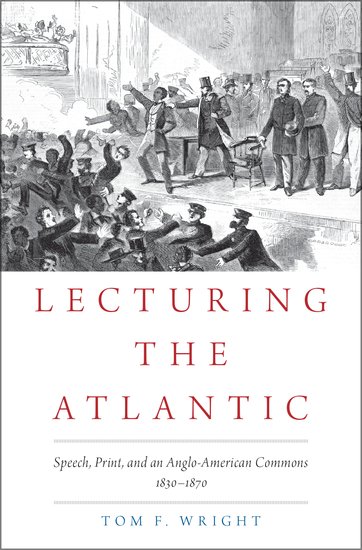Tom F. Wright. Lecturing the Atlantic: Speech, Print, and an Anglo-American Commons, 1830-1870. Oxford University Press, 2017. 264p., ill. ISBN 9780190496791. US$ 74.00 (hardcover).
At a time when public figures, the media, and the public are locked in an ongoing daily battle to define the truth, it feels wise to draw our attention to the relationship among public figures, the media, and the public in a period other than our own. In his new book, Lecturing the Atlantic: Speech, Print, and an Anglo-American Commons, 1830-1870, Tom F. Wright does just that. Focusing on the defunct model of public programming known as the American lyceum movement, Wright seeks to demonstrate how the movement’s lectures, delivered by some of the most prominent public figures of the day, were not just local, rhetorical acts aimed at American nation-building, but fully “international and cross-media” (3). The arguments in Lecturing the Atlantic thus focus on either the ways in which the lectures were “international” or the ways in which they were “cross-media.”
While there are many ways in which these American lectures could be considered to have international awareness (a topic explored in Wright’s earlier edited volume, The Cosmopolitan Lyceum), Wright in this book equates “international” primarily with the “investment” in what he calls an “Anglo-American commons” (3) – that is, a shared, transatlantic culture or imaginary. By cross-media, Wright means how, “thanks to a proliferating culture of reportage, transcription, and commentary, the lyceum was a matter as much of print as of performance” (6). In other words, because of newspaper summaries of the lectures, more people were able to consume lectures in print than in person. On the one hand, this allowed more people to acquire more information: general education at its best. On the other, the press often re-interpreted and/or critiqued a given lecture through its summary, and thus assigned it meanings and values that the lecturer may not have intended.
The book itself is divided into 6 chapters, with each chapter focusing on a specific lecturer and the ways in which some of their lectures focused on Britain. Wright, for example, covers “Britain and Antislavery: Frederick Douglass’s Transatlantic Rhetoric” in Chapter 2 and “Britain as Order: Listening to Ralph Waldo Emerson’s ‘England’” in Chapter 3.
Lecturing the Atlantic is strongest when demonstrating the interaction between oratory and print and the profound consequences of that relationship – consequences that have been amplified by the proliferation of modern media technologies. The emphasis on the Anglo-American commons, however, at times seems overstated and often feels like an “add-on” to an otherwise compelling portrait of the dynamic between the lecture and the newspaper. The book might have read better if its chapters were posited as themed case studies of this lecturing-reporting relationship, rather than expressions of two simultaneous arguments with no clear connection to one another.
Despite its popularity in the nineteenth century and its enduring effect on all realms of American culture, the American lecture circuit still remains a relatively unstudied and unimagined entity. Wright has dedicated himself to surfacing the more unseen aspects of this important cultural catalyst. It is a site of historical activity to which we should all devote some attention as we tweet, post, blog, or otherwise transcribe and re-inscribe the words of all the modern-day lecturers, celebrities, and news reports that come across our screens.
Nora Lessersohn
Harvard University


